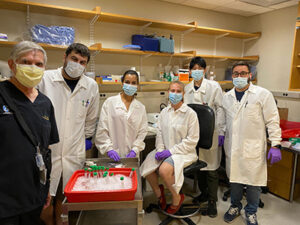
Once a problem primarily in developed, Western nations, atherosclerosis is on the rise in developing countries and has become a major cause of morbidity and mortality worldwide. As the burden of atherosclerosis has shifted geographically and socioeconomically, the way in which the disease is approached and treated has shifted as well. Peter Libby, MD, a cardiovascular medicine specialist at Brigham and Women’s Hospital, has helped drive the latter of these changes.
The author of more than 1,000 peer-reviewed studies, reviews, chapters and other publications over the past 40+ years, Dr. Libby has made the study of atherosclerosis his life’s work, translating basic bench science to clinical applications and transforming patient care.
“I enjoy working on big problems, and atherosclerosis is a big problem,” he said. “No longer is the classic case a middle-aged white male with hypertension and hypercholesterolemia who smoked cigarettes. Now, the disease affects younger people and more women than previously.”
Evolving Concepts of Atherogenesis
For decades, atherosclerosis was viewed as a lipid storage disease: Fat builds up in an artery wall and pinches the blood vessel, causing a lack of blood flow that leads to a heart attack or stroke or jeopardizes the viability of a limb.
Dr. Libby has deconstructed that notion by calling attention to the role of inflammation in atherosclerosis and identifying the mechanisms by which atherosclerotic lesions can cause blood clots by bursting plaques open or otherwise disrupting the lining of arteries instead of gradually clogging the vessels with fatty deposits.
“Rather than elevated low-density lipoprotein (LDL) cholesterol, an elevation in triglyceride-rich lipoproteins (GRL) and low high-density lipoprotein (HDL) now comprise the major pattern of lipid abnormality in many patients who are treated for atherosclerotic cardiovascular disease,” he wrote in a recent review published in Nature.
In addition to reassessing lipid risk factors, Dr. Libby has focused on inflammation as a driver of atherosclerosis. Inflammation does not supplant or demote risk due to lipids or other traditional factors. Rather, inflammatory responses provide a series of pathways that link them to atherosclerosis.
Cardiovascular Benefits of Targeting Inflammation
Dr. Libby’s review article in Nature points to recent evidence showing that targeting inflammation can reduce cardiovascular events even in individuals who have already been treated with a full panel of effective standard therapies. One such piece of evidence is a study he instigated and helped to lead, which was the first large-scale clinical trial targeting inflammation. This study in over 10,000 patients used a monoclonal antibody to block the action of the proinflammatory cytokine interleukin-1 beta (IL-1β).
The trial demonstrated that patients with previous myocardial infarctions who were receiving the full complement of standard of care were able to reduce recurrent events by 15 percent with the anti-inflammatory therapy. Moreover, in patients whose inflammation had a better than average response to the treatment, deaths due to cardiovascular disease decreased by over 30 percent, as did deaths due to all causes — a result Dr. Libby called “the holy grail” of clinical trials.
“I started investigating IL-1β in 1986 and have spent decades studying inflammation as a lesion-producing mechanism,” Dr. Libby said. “The link between risk factors and the way in which lesions cause clinical events is not at all what people used to think — that fatty plaque grows until it blocks a blood vessel.”
According to Dr. Libby, this trial and those that followed showed the benefit of blocking various aspects of inflammatory response. “For generations, clinicians have tried to treat atherosclerosis by bypassing blockages with surgery, squeezing them with angioplasty or propping arteries open with stents,” he said. “These interventions are good for relieving blood flow blockages and hence chest discomfort symptoms [angina]. However, they generally don’t prevent heart attacks because they don’t address the underlying abnormalities in the atherosclerotic plaque that actually cause sudden blood clot formation.”
One Foot in Basic Science, the Other in Clinical Practice
Libby and his colleagues at the Brigham have followed his IL-1β research with new studies of anti-inflammatory strategies such as interleukin-6 (IL-6), a “messenger” cytokine that may confer anti-inflammatory benefits while leaving host defense mechanisms intact. Other groups have explored the use of colchicine, an anti-inflammatory medicine used in gout.
Dr. Libby, with Brigham colleagues Aruna D. Pradhan, MD, MPH, MSc, and Paul M. Ridker, MD, MPH, is also conducting a large investigation in patients with high triglyceride concentrations using a novel agent that can be combined safely with statins.
“Like many of my colleagues here at the Brigham, I have one foot in basic science and the other in clinical practice,” Dr. Libby said.
Dr. Libby’s work reflects the Brigham’s leadership in cardiovascular research and patient care. The hospital is one of the few academic centers in which basic science labs doing fundamental research collaborate with large-scale clinical trial groups to bring research advances to patients in a seamless fashion. Patients at the Brigham are able to take advantage of resulting new therapies, and the work is informing guidelines and changing clinical practice worldwide.